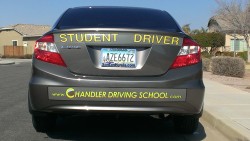- They’ve successfully completed a professional (in car) driving course. ✔
- They’ve demonstrated good decision-making skills, when making “real life” choices. ✔
- They take the responsibilities of being an independent driver, seriously. ✔
- They’ve completed the 30 hours required by M.V.D. (and then some we hope). ✔
- Now they are asking about (enter sound of screeching tires here) having a car of their own.
The prospect of releasing responsibility of being the taxi, for your teen, can be bittersweet. The idea of buying a car for your teenager, can bring back the memories of watching them peddle down the sidewalk on their first, solo, two-wheel bike ride. You might think back to how you gradually worked them up to it, by starting them off riding a tricycle. Next, they used training wheels for a time, and when your child was well prepared, you removed them.Your family established certain safety rules, such as wearing a helmet, boundaries of travel, and about being able to be in communication. You even taught them how to keep their bike in good working condition.
These same principles apply when buying a car for a teenager. Look at it this way. If you have decided that they are ready, then you just need to tweak the safety rules to apply to driving. Let’s face it, haven’t you been gradually been doing this all along? Just as you did their bike, you need to know how to pick the most appropriate vehicle for them. Here is what is recommended.
Safety is essential.
- Anti-lock brake system (ABS): Readily available, anti-lock brakes prevent the wheels from stopping completely during hard braking. Because the wheels don’t lock up, even during emergency braking on slippery surfaces, they enable the driver to retain steering control.
- Electronic stability control (ESC): This feature prevents a car from rotating, such as when going through a turn a bit too fast for the conditions. ESC can be especially welcome in bad weather. All new cars and light-duty trucks are now equipped with ESC. On older cars, ESC may have been optional. Make sure the specific used car you’re buying, has it (if buying used).
- Head-protecting side air bags: Side and side-curtain air bags have been shown to provide real protection in a side impact.
- Adjustable/Lockable head restraints: Adjusted properly, they offer protection against whiplash.
Consider crash worthiness:
You’ll want to consider crash test results for the vehicle. IIHS’s annual “Top Safety Picks” list reflects its most recommended choices, and to qualify, models must receive a “Good” rating in all crash tests. With NHTSA ratings, parents should select vehicles with five-star (or mostly five-star) crash test scores.For more information visit either of these sites. http://www.iihs.org/ratings/ or http://www.safercar.gov/Safety+Ratings OR http://www.safercar.gov/Safety+Ratings
Just enough speed:
This means, find a car that will not tempt your teen to speed. V-8s have more power than a new independent driver needs. Most have learned on a V6, and know how to control the car with that much power. There are some good recommended V4s out there if you really want to limit the lead footed driver.
Size does matter:
Midsize vehicles are best because of their ideal mix of crash protection and maneuverability. “Big cars are too hard to handle, and small are too vulnerable, so we prefer midsize,” says Automobile Club of Southern California research manager Steve Mazor. AAA recommends that parents avoid SUVs when shopping for teen drivers, saying that the vehicles are “more prone to roll over in extreme driving conditions.” Still, the organization concedes that newer models are safer than older ones, because they offer stability control. If you think you need the roominess of an SUV, AAA recommends that parents purchase a newer model. These days the cross-over SUV’s offer some good selections.
Used or new:
Keeping standards in mind, it is not impossible to find a reasonably priced used car, one that’s safe and in good shape. Consumer Reports recently released their list of “The Best Used Cars for Teens”. They want to remind you that you should check their crash test results. You can check out the list on the site below. http://www.consumerreports.org/cro/2012/07/best-used-cars-for-teens/index.htm
Reliability goes with responsibility:
It’s ok to compromise on some things, but not on general upkeep. All vehicle owners should know how to do routine maintenance like changing a tire, how to check tire pressure, checking fluids, and even know how to wash it correctly. They should have an emergency road kit in the car, and know how to use it too. No matter if you decide on a new or gently used car, the better maintained, the lower the risk that it will breakdown on the road. It will also last longer, saving money on repairs.
When it’s all said and done and the car is parked in the driveway, we want to remind you to have a discussion about safety and responsibility. If you don’t already have one, establish a “Parent-Teen Driving Contract”. If you want, we have some here at the driving school. Call, we will be happy to get it to you.
Remember, adequate driver’s training is an essential first step in instilling safe driving habits. If they haven’t checked that off the list yet, call us. We are here to create safer roads, one new driver at a time. Buying a car for a teenager is the next step in their growing independence. When you and your teen know what to look for, the process will be a smoother and more enjoyable one.
Please leave your comments on our Facebook page, we’d love to hear from you!


